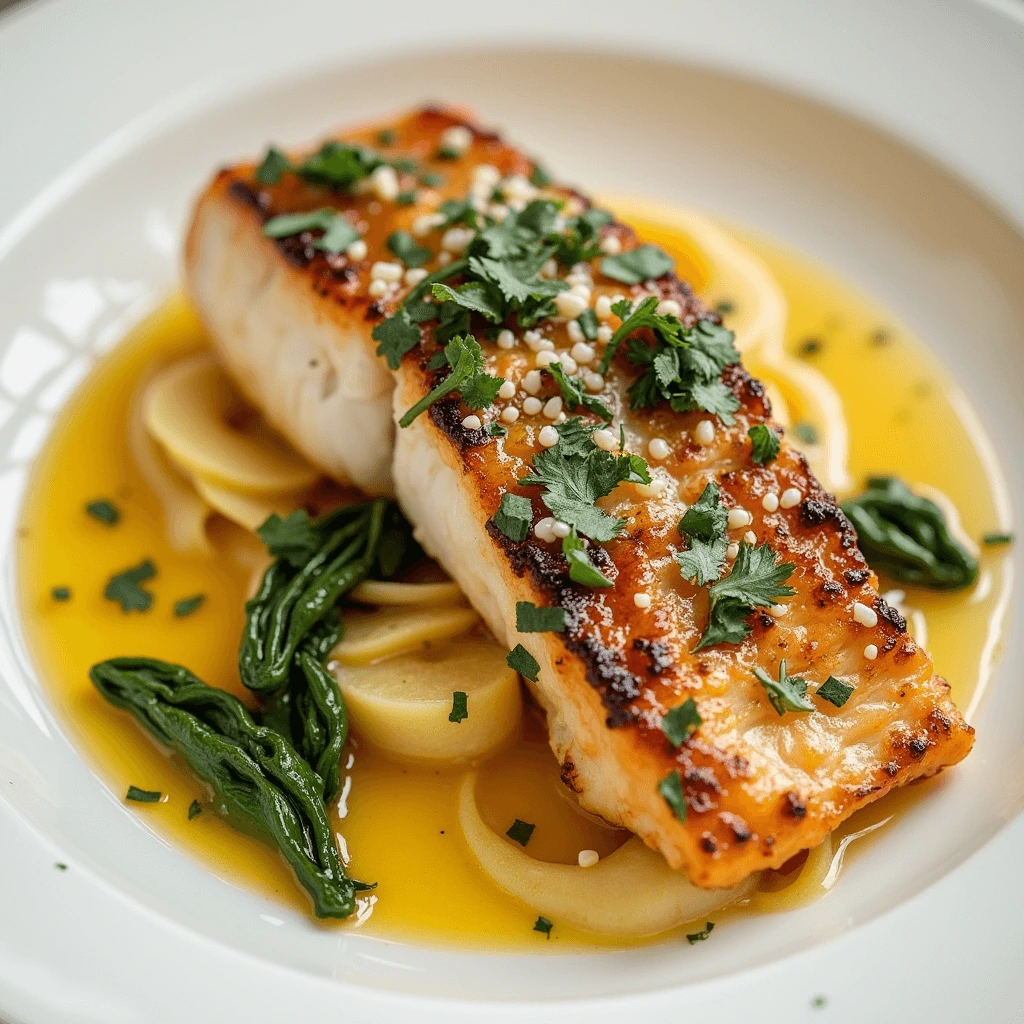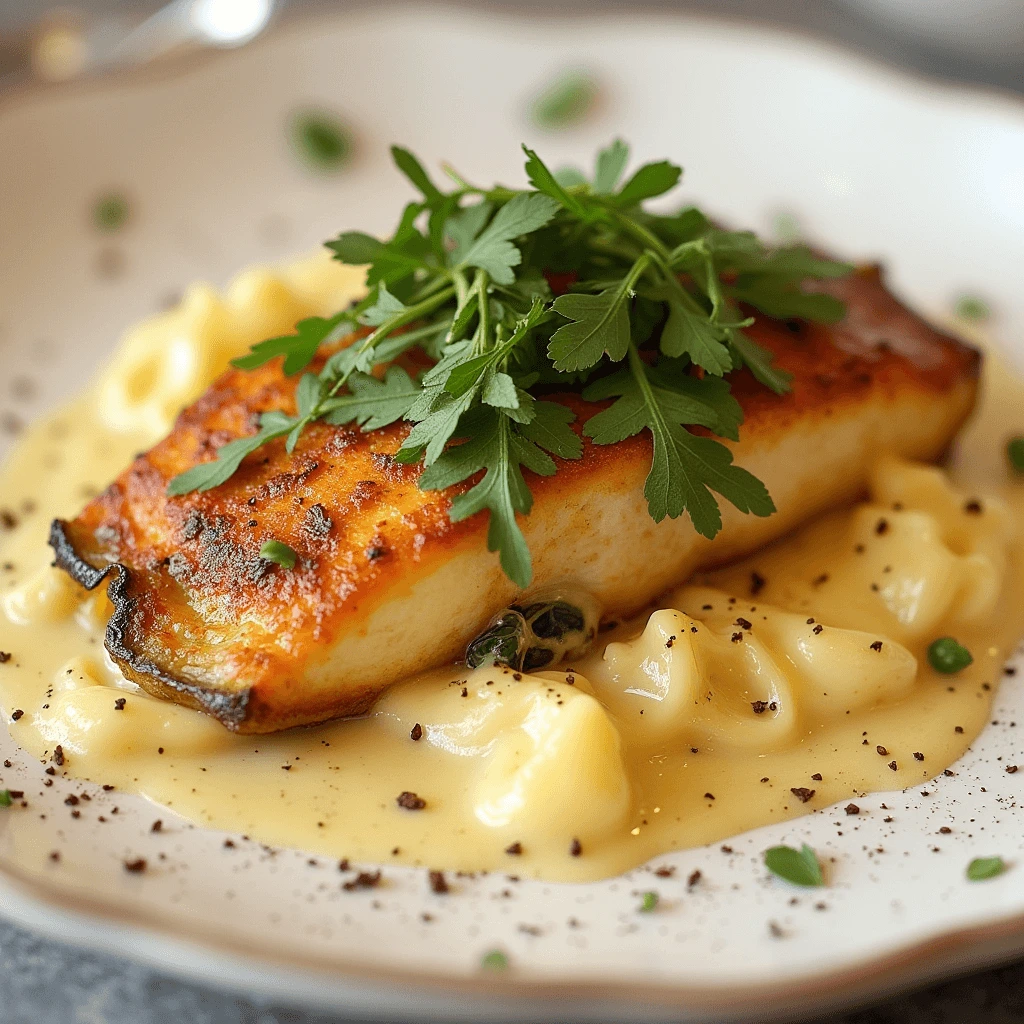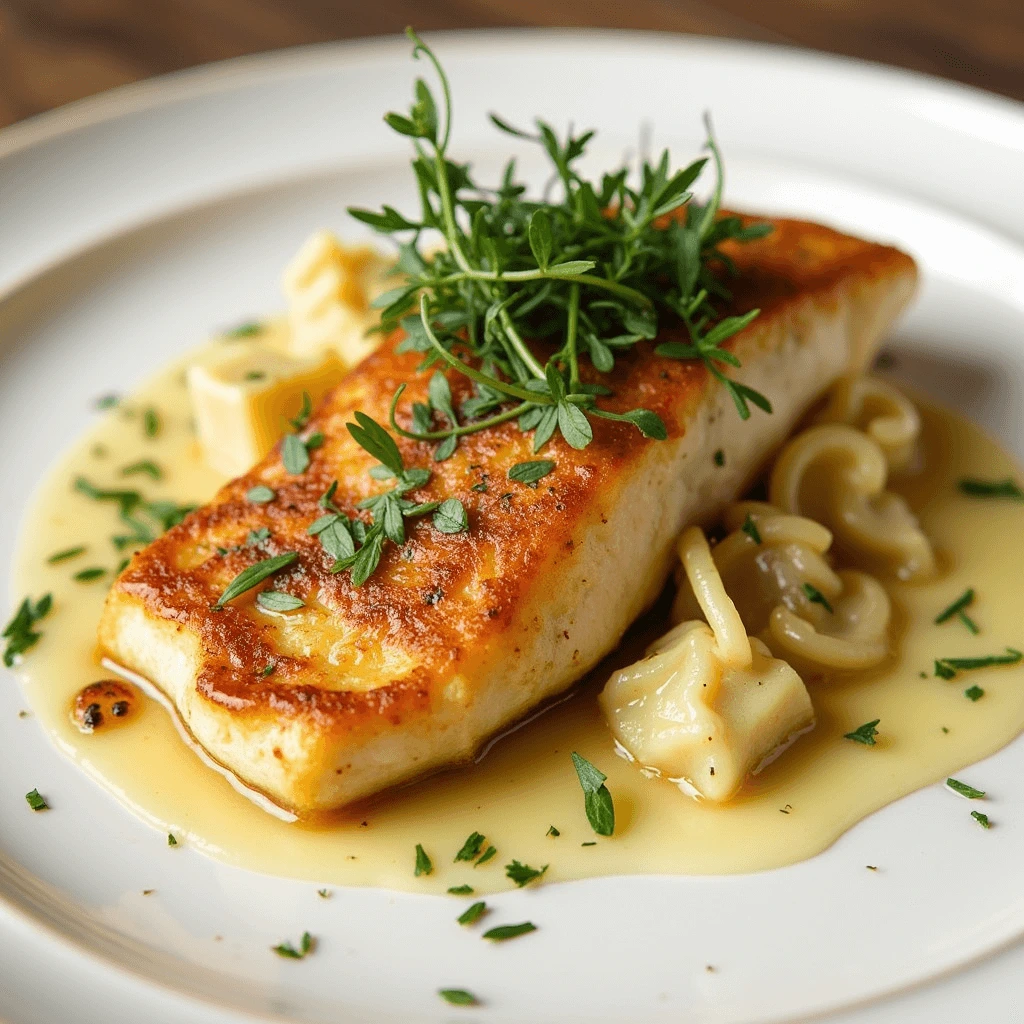Best Fish Florentine Recipe for a Quick and Tasty Meal
If you’re looking for a quick and delicious seafood meal, this Fish Florentine recipe is the perfect choice. It’s a creamy, cheesy, and comforting dish that comes together in just 30 minutes, making it an ideal option for busy weeknights.
Fish Florentine is a classic dish featuring tender white fish fillets cooked in a rich and flavorful spinach sauce. The combination of buttery garlic, Parmesan cheese, and heavy cream creates a luscious texture that perfectly complements the delicate fish. Whether you use cod, tilapia, or haddock, this recipe ensures a moist and flaky fish every time.
One of the best things about this dish is that it’s made in one pan, meaning fewer dishes to wash! Plus, it’s incredibly versatile—you can tweak the ingredients to fit your dietary preferences, whether you prefer dairy-free alternatives, low-carb modifications, or different protein options like chicken or shrimp.
In this post, you’ll learn:
What makes Fish Florentine special and its origins
The best ingredients for a flavorful and creamy dish
Step-by-step instructions for making the perfect Fish Florentine
Pro tips to avoid common mistakes and enhance flavor
Variations and serving ideas to customize the dish to your taste
Table of Contents
What Is Fish Florentine?
Fish Florentine is a classic seafood dish that features white fish fillets served with a creamy spinach sauce. The term Florentine refers to dishes prepared in the style of Florence, Italy, which typically include spinach and a rich, buttery sauce. While this style is often associated with eggs (Eggs Florentine) or chicken (Chicken Florentine), it also pairs exceptionally well with delicate white fish.
The Origin of Florentine-Style Dishes
The Florentine cooking style traces its roots back to Catherine de’ Medici, an Italian noblewoman from Florence who married King Henry II of France in the 16th century. Legend has it that she introduced spinach-based dishes to French cuisine, inspiring the Florentine-style recipes we know today. Over time, chefs began incorporating creamy sauces, cheese, and proteins like fish or chicken to enhance these dishes.
Why White Fish Works Best for Florentine Recipes
The mild, flaky texture of white fish fillets makes them an excellent base for Florentine-style cooking. Some of the best fish choices include:
Cod – Mild, flaky, and holds up well in creamy sauces.
Tilapia – A budget-friendly option with a mild taste.
Haddock – A slightly firmer texture that absorbs flavors beautifully.
Halibut or Sole – Great for a more delicate, melt-in-your-mouth experience.
The rich spinach sauce provides a smooth, velvety contrast to the light, flaky fish, creating a perfectly balanced dish.
Why You’ll Love This Dish
- Quick & Easy: Ready in just 30 minutes, making it a great weeknight dinner.
- Rich & Creamy: The combination of garlic butter, Parmesan, and heavy cream creates a luxurious texture.
- One-Pan Recipe: Minimal cleanup with maximum flavor.
- Customizable: Can be made low-carb, dairy-free, or with different proteins like shrimp or chicken.
Whether you’re a seafood lover or just looking for a comforting yet nutritious meal, Fish Florentine is a must-try recipe!
Ingredients for the Best Fish Florentine Recipe

To create the best Fish Florentine, you’ll need a combination of fresh, high-quality ingredients that enhance both the flavor and texture of the dish. Below, we’ll break down the key components and their roles, along with optional ingredients to customize the recipe to your liking.
Choosing the Right Fish
The foundation of this dish is tender, flaky white fish that pairs well with the rich, creamy spinach sauce. Here are some of the best options:
Cod – A mild, slightly sweet fish that holds up well in sauces.
Tilapia – Affordable and quick-cooking, making it perfect for busy nights.
Haddock – Firm, flaky texture with a mild taste that absorbs flavors well.
Halibut or Sole – A more delicate and buttery option for a luxurious twist.
For the best results, choose fresh or high-quality frozen fish fillets, ensuring they are skinless and boneless for easy cooking.
Essential Ingredients for a Creamy Spinach Sauce
The Florentine sauce is what makes this dish truly special. It’s a smooth, garlicky, and cheesy spinach sauce that perfectly complements the fish.
Garlic – Enhances the sauce with a rich, savory aroma and deep flavor. Freshly minced garlic works best.
Butter or Olive Oil – Used for sautéing the garlic and spinach, adding richness to the dish.
Fresh Spinach – The star ingredient of Florentine-style dishes. It wilts down beautifully into the creamy sauce.
Heavy Cream – Adds a rich, smooth, and creamy consistency to the sauce.
Parmesan Cheese – Adds a slightly nutty, salty flavor that enhances the dish.
White Wine – Provides acidity and a subtle depth of flavor (optional but recommended).
Flour or Cornstarch – Helps thicken the sauce slightly, ensuring a creamy consistency.
Optional Additions for Extra Flavor
While the base ingredients create a rich and delicious sauce, you can enhance the dish further with these optional ingredients:
Mozzarella Cheese – Melted on top for an extra cheesy touch.
Lemon Zest or Juice – Brightens up the dish with a fresh, citrusy contrast.
Red Pepper Flakes – Adds a subtle kick for those who like a little heat.
Crispy Bacon Bits – A smoky, savory addition for more depth of flavor.
Seasonings to Enhance Flavor
To make sure your Fish Florentine is perfectly seasoned, don’t forget these key ingredients:
Salt and Black Pepper – Enhances the natural flavors of the fish and sauce.
Italian Seasoning – A blend of basil, oregano, and thyme adds a herby aroma.
Nutmeg (A Pinch) – A traditional Florentine ingredient that subtly enhances the cream sauce.
Final Thoughts on Ingredients
By using the right combination of fish, creamy sauce, and flavorful seasonings, you’ll create a restaurant-quality Fish Florentine right in your own kitchen. Now that you know what you need, let’s move on to the step-by-step instructions to bring this dish to life!
Step-by-Step Guide: How to Make Fish Florentine
Making Fish Florentine is easier than you think! This one-pan recipe ensures a flavorful dish with minimal cleanup. Below is a detailed, step-by-step guide to help you create a perfectly cooked fish with a rich and creamy spinach sauce every time.
Step 1: Prepare the Fish
The key to a delicious Fish Florentine is using fresh, high-quality white fish fillets and seasoning them properly.
Pat the Fish Dry – Use paper towels to remove excess moisture to ensure even cooking.
Season Generously – Sprinkle salt, black pepper, and Italian seasoning over both sides of the fillets.
Dredge Lightly (Optional) – Lightly coat the fish in flour or cornstarch for a subtle crispiness when searing.
Cooking the Fish:
Heat a large pan over medium heat and add butter or olive oil.
Sear the fish fillets for 2-3 minutes per side until they develop a light golden crust. (They don’t need to be fully cooked yet, as they’ll finish cooking in the sauce.)
Remove the fish from the pan and set it aside on a plate while you make the creamy spinach sauce.
Pro Tip: Be gentle when flipping the fillets to keep them from breaking apart.
Step 2: Make the Creamy Spinach Sauce
The Florentine sauce is what makes this dish truly special. It’s rich, garlicky, and packed with flavor!
How to Make the Sauce:
Sauté the Garlic & Spinach
- In the same pan, add a bit more butter or olive oil.
- Stir in the minced garlic and cook for about 30 seconds until it releases its aroma.
- Toss in fresh spinach and cook until it wilts down, about 2-3 minutes.
Deglaze the Pan (Optional but Recommended)
- Pour in a splash of white wine and let it simmer for 1 minute to enhance the depth of flavor.
Add the Cream & Cheese
- Stir in heavy cream and let it simmer for 2-3 minutes, allowing it to thicken slightly.
- Sprinkle in Parmesan cheese and stir until melted and combined.
- If needed, use a teaspoon of cornstarch mixed with water to thicken the sauce.
Adjust Seasoning
- Taste and add salt, pepper, and a pinch of nutmeg for extra depth.
- Add red pepper flakes if you like a bit of spice.
Pro Tip: If the sauce becomes too thick, add a splash of milk or broth to loosen it up.
Step 3: Combine and Cook Everything Together
With the sauce prepared, it’s time to combine all the ingredients!
Return the Fish to the Pan
- Nestle the seared fish fillets back into the pan, spooning some of the creamy spinach sauce over the top.
Let the Fish Simmer
- Cover the pan and let the fish simmer for 3-5 minutes over low heat until it’s fully cooked and flaky.
Final Touches
- Sprinkle extra Parmesan cheese on top.
- (Optional) Add a handful of shredded mozzarella and let it melt for a cheesy crust.
Pro Tip: The fish is done when it flakes easily with a fork and reaches an internal temperature of 145°F (63°C).
Step 4: Serve and Enjoy!
Your Fish Florentine is now ready to serve! Here are some great serving ideas:
With a Side of Rice – Garlic butter rice or creamy risotto complement the dish perfectly.
Over Mashed Potatoes – A great option for a comforting meal.
With Crusty Bread – Perfect for soaking up the extra creamy sauce.
Alongside Roasted Veggies – A light and nutritious pairing.
Final Thoughts
This easy Fish Florentine recipe is perfect for any night of the week. The combination of flaky white fish and creamy spinach sauce creates a restaurant-quality meal with minimal effort.
Fish Florentine Recipe – Quick Table Format
| Category | Details |
|---|---|
| Recipe Name | Fish Florentine Recipe |
| Preparation Time | 10 minutes |
| Cook Time | 20 minutes |
| Total Time | 30 minutes |
| Servings | 4 |
| Type of Cuisine | Italian-American |
| Difficulty | Easy |
| Key Ingredients | White fish fillets (such as cod, haddock, or tilapia), fresh spinach, garlic, cream, and Parmesan cheese. |
| Diet Type | Low-carb, gluten-free (if using GF thickener) |
Ingredients
| Ingredient | Amount |
|---|---|
| White fish fillets | 4 (about 1.5 lbs total) |
| Fresh spinach | 4 cups (packed) |
| Garlic (minced) | 3 cloves |
| Butter | 2 tablespoons |
| Olive oil | 1 tablespoon |
| Heavy cream | 1 cup |
| Grated Parmesan cheese | ½ cup |
| Lemon juice (optional) | 1 teaspoon |
| Salt | To taste |
| Black pepper | To taste |
| Nutmeg (optional) | Pinch |
Tips for the Perfect Fish Florentine

Making Fish Florentine is simple, but a few expert tips can take your dish from good to restaurant-quality. Here are the best tips and tricks to ensure your fish is perfectly cooked and your sauce is creamy and flavorful every time.
1. Choosing the Best Fish for Florentine
The type of fish you use can greatly impact the taste and texture of the dish. Follow these tips for the best results:
Opt for Mild, Flaky White Fish – Cod, tilapia, haddock, halibut, or sole work best. These types of fish absorb the creamy sauce beautifully without overpowering it.
Use Fresh or High-Quality Frozen Fish – If using frozen fish, thaw it completely and pat it dry to prevent excess water from diluting the sauce.
Skinless and Boneless Fillets are Best – This makes cooking easier and ensures a smooth, enjoyable bite.
Pro Tip: If you prefer a firmer texture, go for haddock or halibut. If you like a more delicate, buttery texture, opt for sole or cod.
2. How to Cook the Fish Perfectly
Overcooking is one of the biggest mistakes when making Fish Florentine. Follow these tips to achieve tender, flaky fish every time:
Sear on Medium Heat – Cooking the fish too fast on high heat can make it dry. Medium heat allows for even cooking.
Don’t Overcook – The fish is done when it flakes easily with a fork and reaches an internal temperature of 145°F (63°C).
Let the Fish Rest After Cooking – This helps retain moisture and keeps it tender and juicy.
Pro Tip: If your fish starts to break apart, don’t worry! The creamy sauce will still hold everything together.
3. Making the Creamiest Florentine Sauce
The Florentine sauce is the heart of this dish, and getting the right consistency and flavor balance is key.
Use Heavy Cream for a Velvety Texture – This creates a rich, luscious sauce. If you prefer a lighter option, you can use half-and-half or coconut milk.
Don’t Skimp on Parmesan – It adds umami, saltiness, and depth of flavor. Always use freshly grated Parmesan for the best results.
Deglaze with White Wine – A splash of dry white wine enhances the flavors of the sauce. If you don’t want to use wine, a little chicken broth works as a substitute.
Season in Layers – Season each step of the cooking process rather than just at the end. This ensures a well-balanced and flavorful sauce.
Pro Tip: If the sauce becomes too thick, add a small splash of milk or broth to loosen it up. If it’s too thin, simmer for a few extra minutes or add a cornstarch slurry (1 teaspoon cornstarch + 1 teaspoon water).
4. Avoiding Common Mistakes
Here are some common mistakes and tips to prevent them:
Adding Too Much Spinach at Once – Fresh spinach wilts quickly. Introduce it in small portions to guarantee even cooking.
Skipping the Garlic & Onion – These aromatics build the foundation of the sauce’s flavor.
Cooking the Fish in the Sauce for Too Long – Once the fish is returned to the pan, let it simmer just until cooked through. Overcooking can make it fall apart.
Not Tasting & Adjusting the Seasoning – The sauce needs balanced saltiness, richness, and a touch of acidity. Season with salt, pepper, or a splash of lemon juice to taste, if necessary.
Pro Tip: If the sauce tastes too rich, a pinch of nutmeg or a splash of lemon juice can help cut through the heaviness.
5. Serving and Storing Fish Florentine
To make the most of your delicious creamy fish dish, follow these serving and storage tips:
Best Sides to Serve With Fish Florentine
- Garlic butter rice – A great way to soak up the creamy sauce.
- Mashed potatoes – Adds extra comfort to the dish.
- Crusty bread – Great for dipping into the flavorful sauce.
- Steamed or roasted vegetables – A healthy, low-carb pairing.
How to Store Leftovers
- Refrigeration: Keep in an airtight container and refrigerate for up to 2 days.
- Reheating: Gently warm over low heat on the stove, adding a splash of broth or milk to keep the sauce creamy.
- Freezing: Not advised, as the creamy sauce may separate when thawed.
Pro Tip: If reheating in the microwave, use short 30-second intervals to prevent overcooking the fish.
Final Thoughts
By following these expert tips, you’ll master the art of making Fish Florentine with perfectly cooked fish and a creamy, flavorful sauce. Whether you’re making it for a quick weeknight dinner or a special occasion, this dish is sure to impress.
Now that you know all the secrets, it’s time to try this delicious, easy Fish Florentine recipe!
Common Variations and Substitutions

Fish Florentine is a versatile dish, allowing for many variations and ingredient swaps based on your dietary preferences, availability of ingredients, or personal taste. Below are some creative variations and smart substitutions to help you customize this delicious meal to suit your needs.
1. Best Fish Substitutes for Florentine
While white fish fillets are traditional for Fish Florentine, you can use other types of fish or even swap it for another protein.
Alternative Fish Options:
Salmon – For a richer, more flavorful twist, try Salmon Florentine. The fatty texture pairs beautifully with the creamy spinach sauce.
Trout – A delicate, slightly sweet fish that works well in this recipe.
Sea Bass or Grouper – Adds a slightly firmer, meatier bite while still absorbing the creamy sauce.
Mahi Mahi – Holds up well to cooking and offers a mild, slightly sweet taste.
Non-Fish Protein Substitutes:
If you’re not in the mood for fish, try these protein alternatives:
Chicken Breast or Chicken Thighs – Perfect for making Chicken Florentine! Sear the chicken first, then simmer in the creamy sauce.
Shrimp or Scallops – Adds a seafood twist while keeping the dish light and elegant.
Firm Tofu or Paneer – A great vegetarian option that absorbs the flavors of the sauce well.
Pro Tip: If using chicken, cook it thoroughly before adding it to the sauce. For shrimp or scallops, add them toward the end to prevent overcooking.
2. Dairy-Free and Lighter Alternatives
If you’re looking for a healthier or dairy-free version, here are some great substitutions:
Cream Alternatives:
Coconut Milk – A great dairy-free substitute that still provides richness. Opt for full-fat coconut milk to achieve a rich, creamy texture.
Cashew Cream – Made by blending cashews with water for a creamy, nutty alternative.
Greek Yogurt or Low-Fat Sour Cream – Adds creaminess while reducing fat and calories.
Cheese Substitutes:
Nutritional Yeast – Provides a cheesy flavor for a dairy-free and vegan version.
Dairy-Free Parmesan or Mozzarella – Available in most grocery stores for lactose-intolerant diets.
Butter Replacement:
Olive Oil or Vegan Butter – A great swap that still provides richness to the sauce.
Pro Tip: If using Greek yogurt or sour cream, add it at the end of cooking on low heat to prevent curdling.
3. Low-Carb and Keto-Friendly Adjustments
Fish Florentine is already a great low-carb meal, but you can make a few tweaks to make it fully keto-friendly:
Low-Carb Thickening Options:
Cream Cheese – Adds thickness and richness without using flour.
Xanthan Gum – A tiny pinch (⅛ teaspoon) thickens the sauce without adding carbs.
Reduce the Cream – Simmer the sauce longer to naturally thicken it without any thickeners.
Keto-Friendly Side Dish Ideas:
Instead of serving it with pasta or rice, try these low-carb sides:
Cauliflower Mash – A creamy, buttery substitute for mashed potatoes.
Zucchini Noodles (Zoodles) – A great alternative to traditional pasta.
Steamed Asparagus or Roasted Broccoli – Adds a fresh, crisp contrast to the rich sauce.
Pro Tip: Avoid using cornstarch or flour for thickening if you’re following a strict keto diet.
4. Flavor Enhancements and Extra Additions
Want to add even more depth to your Fish Florentine? Try these optional ingredients:
Extra Herbs & Seasonings:
Basil or Fresh Parsley – Adds a fresh, aromatic finish to the dish.
Nutmeg (A Pinch) – A traditional Florentine ingredient that enhances the creaminess of the sauce.
Smoked Paprika – Adds a mild smoky flavor that pairs well with fish.
Extra Cheesy Variations:
Mozzarella Cheese – Sprinkle on top and broil for a cheesy crust.
Gruyère or Asiago – Adds a deeper, nutty flavor to the sauce.
Wine or Broth for More Depth:
White Wine – A splash of dry white wine like Sauvignon Blanc or Pinot Grigio enhances the sauce’s flavor.
Chicken or Fish Broth – Adds depth if you prefer not to use wine.
Pro Tip: If adding cheese on top, place the pan under the broiler for 2-3 minutes for a golden, bubbly finish.
5. Making It a One-Pan Meal
If you love one-pan meals, you can easily make Fish Florentine into a complete meal by adding vegetables and sides directly into the pan.
Vegetable Add-Ins:
Mushrooms – Sauté with garlic before adding the spinach.
Cherry Tomatoes – Adds a pop of sweetness and color.
Artichoke Hearts – Complements the creamy spinach sauce beautifully.
Adding Pasta or Grains:
Pasta Florentine – Cook pasta separately, then toss it into the sauce with the fish.
Rice or Quinoa – Cooked grains can be mixed into the sauce for a heartier dish.
Pro Tip: If adding pasta, reserve ½ cup of pasta water to help create a silkier sauce.
Final Thoughts
Fish Florentine is incredibly versatile, allowing you to customize it based on your dietary needs, flavor preferences, and available ingredients. Whether you want a low-carb version, a dairy-free alternative, or a one-pan meal, there are plenty of ways to make this dish your own.
Conclusion: Why You’ll Love This Fish Florentine Recipe
Fish Florentine is the perfect quick and delicious meal that brings together tender, flaky fish, a rich and creamy sauce, and nutritious spinach for a dish that feels both indulgent and wholesome. Whether you’re preparing a weeknight dinner or a special meal for guests, this recipe delivers restaurant-quality flavors with minimal effort.
Recap: What Makes This the Best Fish Florentine Recipe?
Easy to Make – A simple, straightforward recipe that’s beginner-friendly.
Rich and Creamy Sauce – A perfect balance of Parmesan, cream, and garlic.
Healthy and Nutritious – Packed with protein, healthy fats, and vitamins.
Customizable – Works with different types of fish, dairy-free alternatives, or low-carb options.
Quick Cooking Time – Ready in under 30 minutes, making it an ideal weeknight dinner.
If you’re looking for a comforting yet elegant seafood dish, Fish Florentine is an excellent choice. The combination of creamy Parmesan sauce and fresh spinach complements the mild, delicate fish beautifully, creating a harmonious blend of flavors that will leave you craving more.
Encouragement to Try the Recipe
Now that you have all the tips, variations, and step-by-step instructions, it’s time to try making Fish Florentine in your own kitchen!
Enjoy your homemade Fish Florentine, and happy cooking!

